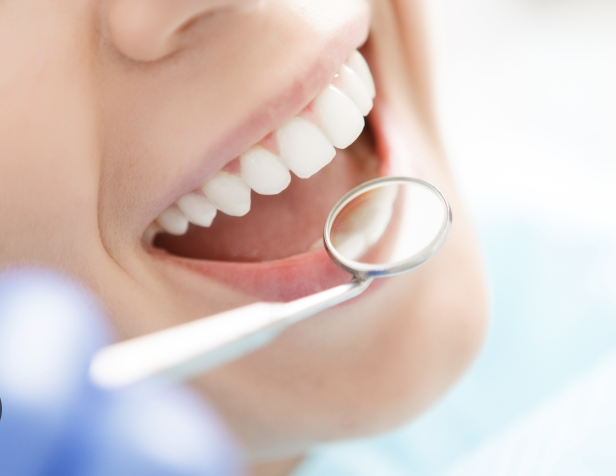America’s Dental Health
Is in Trouble


Not long ago, Dr. Suzanne Fournier saw a 16-year-old patient with a swollen face and difficulty breathing. Fournier, a dentist who practices at an urban hospital in Louisiana, had to extract six of the teen’s teeth; he was eventually intubated and admitted to the intensive care unit because his airways had closed up.
He survived, but Fournier is worried that there will be more children like him across the country who could come close to death because of the state of their oral health. “I really worry that someone is going to die because they have an abscessed cavity that develops into an infection, and they won’t be able to access care,” she says.
In the U.S., 27% of adults don’t have dental insurance, according to the most recent State of Oral Health Equity in America by the CareQuest Institute for Oral Health, a nonprofit that advocates on behalf of better oral health care. That’s about 72 million Americans. By comparison, 9.5% of adults don’t have health insurance. And though many children can get dental care through Medicaid or the Children’s Health Insurance Program (CHIP), low reimbursement rates mean that many dentists won’t accept those insurance plans, leading to dental-care deserts across the country. Only about half of all children on Medicaid used any dental service in a year, according to an analysis by KFF.
Now, dentists say they’re worried that a perfect storm of public-policy changes could further worsen oral health across the country. Proposed cuts to Medicaid would mean that fewer people will be able access dental care, as federal government staffing purges target places like the prevention division of oral health at the U.S. Centers for Disease Control and Prevention (CDC). What’s more, as states including Florida and Utah vote to ban the addition of fluoride to drinking water and other states consider similar bans, dentists say the oral health of children and adults will suffer.
Why Dental Care Is An Afterthought
America has long separated dental health from medical health. In most cases, Medicare, the federal health insurance program for older adults, doesn’t cover dental care at all. Dental care through Medicaid varies tremendously from state to state, and states are not required to include dental coverage for adults, though they are required to include it for children.
People going onto the Affordable Health Care marketplace for health plans can’t purchase a dental insurance plan independently unless they also purchase a medical health plan. And subsidies offered to lower-income families on the health marketplace don’t apply to dental plans.
People going onto the Affordable Health Care marketplace for health plans can’t purchase a dental insurance plan independently unless they also purchase a medical health plan. And subsidies offered to lower-income families on the health marketplace don’t apply to dental plans.
Even those people with dental insurance coverage often find that their plans don’t cover much outside of a dental cleaning and check-up. About 40% of adults who have health insurance don’t get regular dental care, according to one recent survey from the PAN Foundation, a health care advocacy organization.
Not having dental health care can come with major consequences. Tooth decay and gum disease can exacerbate other health conditions and lead to heart disease, low birth weight in pregnancy, and even respiratory disease. Adults who present to emergency departments for tooth pain often end up with opioid prescriptions, which can lead to addiction.
If children’s teeth hurt, they may have trouble eating, leading to poor nutrition; if they’re in pain, they’re likely to sleep poorly. The CDC estimates that 34 million school hours are lost each year because of unplanned dental issues.
If children’s teeth hurt, they may have trouble eating, leading to poor nutrition; if they’re in pain, they’re likely to sleep poorly. The CDC estimates that 34 million school hours are lost each year because of unplanned dental issues.

“You can find lots of studies that find associations between poor dental care and things like pneumonia and diabetes and heart disease,” says Dr. Lisa Simon, an internal medicine specialist who started her career as a dentist and then went to medical school to focus on oral health care. “But even if you didn’t think about any of those things, how important is it to have a central feature in our face look the way we want to, and not live with pain, and be able to take in nutrition?”
Simon practices in Massachusetts, a state with one of the best dental safety nets in the country, and generous Medicaid benefits compared to those in other states. But she still sees people who have ended up in the ICU because of life-threatening sepsis from a tooth infection, patients who can’t start chemotherapy because they can’t pay to remove their infected teeth, people who won’t even let her look into their mouths because they’re so ashamed. In Massachusetts, fewer than one third of dentists accept Medicaid, which is close to the national average.
“I have gone down to Haiti nine times, and I have never seen the level of decay that I saw when I worked in Florida,” says Fournier, the Louisiana dentist, who previously practiced in Florida.
She and other dentists worry that looming Medicaid cuts would exacerbate the problem; when state budgets are tight, dental care is often one of the first things to go. Massachusetts, for instance, cut Medicaid coverage for adult dental care in 2010 in the aftermath of the Great Recession; dental-related visits at a safety-net hospital increased 14% in the two years after the Medicaid cuts.


